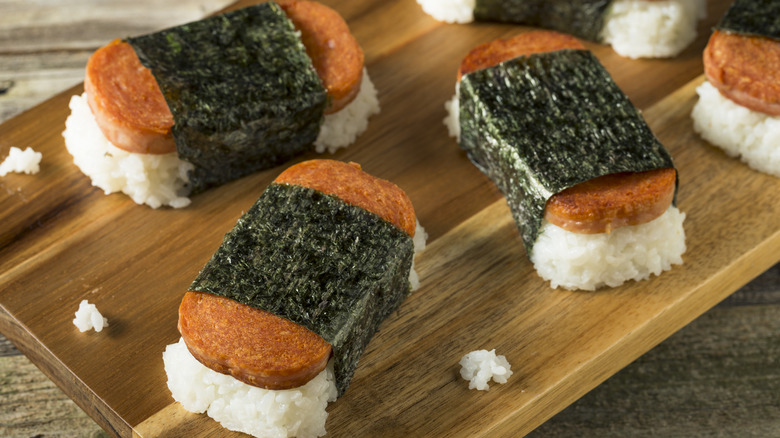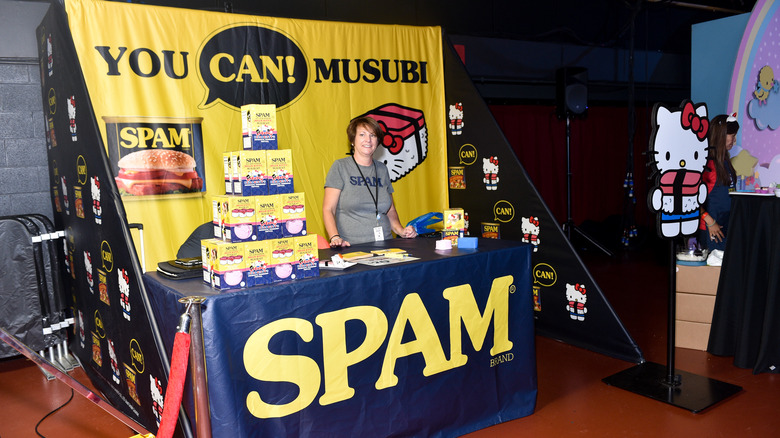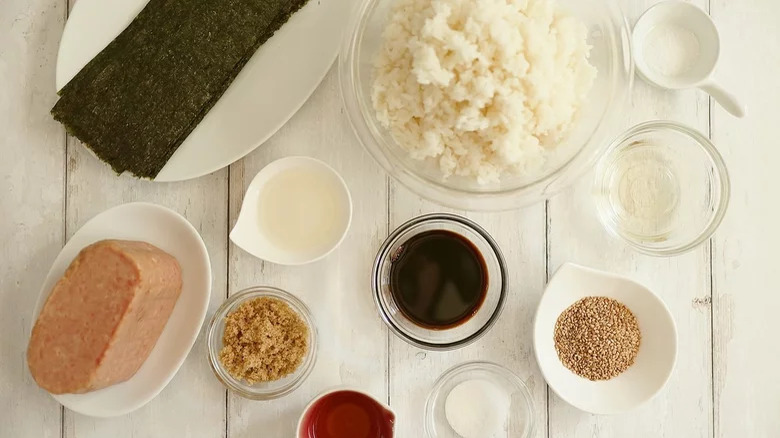The WWII Roots Of Spam Musubi
Spam has been around longer than most people living today. A reincarnation of the original Hormel's Spiced Ham that hit the grocery shelves in 1927, Spam aimed for universal appeal at its 1936 launch, explains Defense Media Network. Accompanied by a polished marketing campaign, the canned meat product was a big win during the Great Depression when cheap food fed hungry families. But it really came into its own during World War II, feeding battlefield troops and spawning regional recipes such as Spam musubi.
The Spam website is deliberately elusive about the name's origin, coyly mentioning a popular belief that Spam derives from select letters within the originally named "Spiced Ham" product. But readers at The Guardian weigh in with some alternatives, including the acronym SPAM from "Special Processed American Meat." Regardless of which is true, if either, Spam is definitely an American creation and one that fueled World War II on multiple levels as battles and occupations spread across the world. Fortunately, it landed in Hawaii where a certain Japanese American lady invented the endearing and enduring recipe for Spam musubi.
Spam spreads its wings
After being heavily incorporated into rations for American troops, Spam began its erratic introduction into global households. According to an episode of The Atlantic's podcast titled "The Global History of Spam Canned Meat," Americans spread more than democracy as its troops deployed and liberated occupied territories during WWII. They also spread Spam love, tossing cans of the meat concoction from trucks or airplanes as they entered countries such as the Philippines, where it continues to be a staple food item.
But Spam arrived early in the Hawaiian Islands due to a strong and established military presence both before and after the Japanese bombed Pearl Harbor. TIME notes that Spam became embedded in local Hawaiian communities and island dishes, giving rise to Spam musubi, invented by Japanese American Barbara Funamura, a resident of Hawaii.
Funamura's creation, which endures some 80 years later, consists of grilled Spam slices resting atop a block of rice and wrapped in thin sheets of nori, an edible dried seafood popular in Japanese dishes, explains SushiSushi. The Spam musubi dish sprang from an existing food known as onigiri, which is a simply compacted rice and nori, often accompanied by furikake seasoning and various toppings, according to The Hawaii Plan. Spam gave it new life with readily accessible canned meat. The dish now holds status as a hand-held convenience food in most Hawaiian towns.
Make your own Spam musubi
Outside the paradise islands of America's 50th state, it may be hard to find prepared Spam Musubi. But no worries, you can make it yourself at home using fresh or leftover canned spam. Tasting Table offers a simple spam musubi recipe, which can be altered with your own ideas or added spices and seasonings.
The process starts with cooking the rice, and then stirring in a mixture of rice wine vinegar, white sugar, and salt, per the recipe instructions, adding sesame seeds for extra flavor and texture. In a separate step, you'll whisk up a sauce using brown sugar, soy sauce, and mirin, and then set it aside. After cutting a block of canned Spam into four slices and frying each in canola oil for a few minutes on each side, you'll have the base for four crispy Spam musubis. Then, just drizzle the soy sauce mixture over the fried Spam, using it to coat the slices as the sauce reduces and caramelizes. Then, form the rice to fit beneath each fried Spam slice and wrap the whole thing with a sheet of nori.
In minutes, you'll have a sweet, salty, and filling version of fast comfort food. Plus, Spam musubi is made from ingredients you can easily keep on hand. It's no wonder that Spam fueled many a weary soldier during the long years of WWII and spawned reliable comfort-food dishes across continents.


